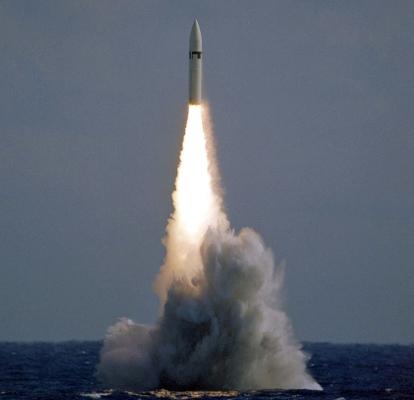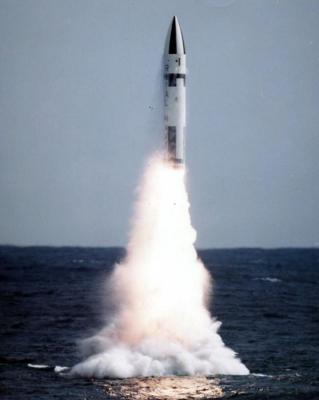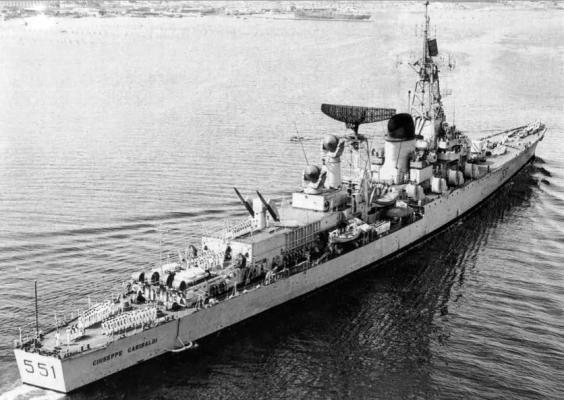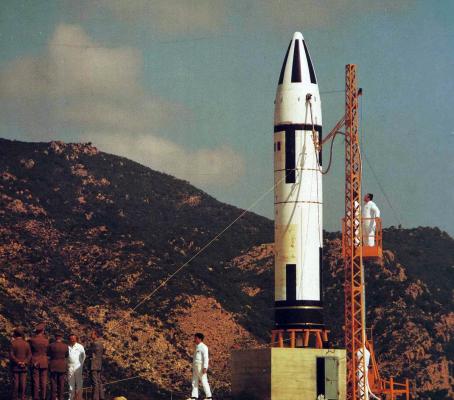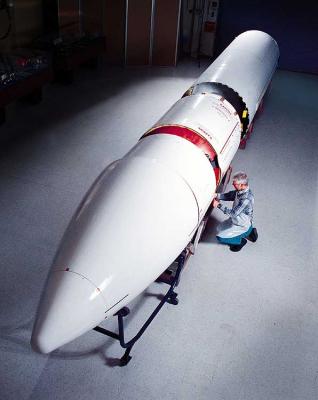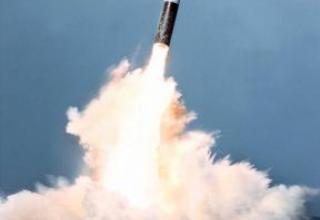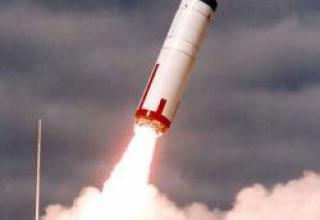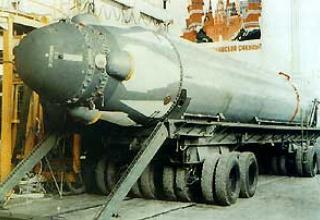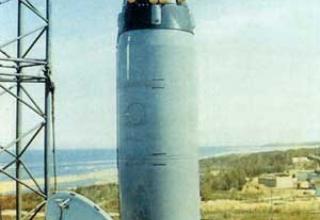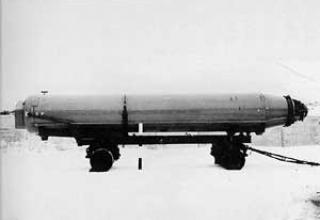The UGM-27C "Polaris-A3" was the last in the family of American "Polaris" SLBMs, the development of which began in 1956. It was adopted for a period of sharp quantitative/quality growth and formation of the last of the three components of the American "nuclear triad" - a group of nuclear submarine strategic missile carriers, known as "41 for Freedom". Formed by the end of 1967, this group began to give way only in the late 1980s to the latest U.S. Navy nuclear missile system Trident - Ohio.
The first missiles of the family - Polaris-A1 and Polaris-A2 - were created in a rather big hurry, which did not allow designers to promptly implement in full the latest technologies. American scientists and engineers were able to maximize their scientific and technical potential for the early 60's in the process of creating the Polaris-A3 SLBM. Significant progress has been made in comparison with previous SLBMs of this family due to the fact that the consortium of SLBM creators, headed by Lockheed Corporation, has introduced a number of fundamental technological improvements - in engine engineering, materials science, solid fuel chemistry, electronics, etc. Thanks to this, almost without enlarging the missile's dimensions ("Polaris-A3" was slightly longer than "Polaris-A1" with the same diameter), it was possible to achieve a sharp increase in range, accuracy and combat efficiency (first of all, by equipping the missile with a splitting head part of a scattering type with three combat units). The successful implementation of strict dimensional restrictions made it possible to arm new SLBMs not only with missile carriers under construction but also with existing SSBNs.
The missile went on flight testing in August 1962 in its prototype version called "Polaris-A3X". The first launch was only partially successful, which, given the many new solutions used to design the missile, was already quite a success. The Polaris-A3 rocket was supposed to be fitted primarily with the latest Lafayette class SSBNs, construction of which began in the USA in 1961 and ended in 1967 (a total of 31 nuclear submarine missiles were built in three submersibles). In addition, these SLBMs were planned to be re-equipped with the first "George Washington" (5 SSBNs, built in 1958-1961) and "Ethan Allen" (5 SSBNs, built in 1961-1962), which were armed with "Polaris-A1" and "Polaris-A2" SLBMs, respectively.
Flight tests of Polaris-A3X SLBMs were conducted at the Eastern Missile Testing Range (Patrick Airbase, Florida). Launch stands LC25A and LC29A were used for the tests. The first launch from the submarine was made in April 1963 and ended in failure. Since June 1963, the new SLBM was designated UGM-27C. The last launch of the Polaris-A3X prototype was in July 1964 (successfully), after which the decision was made to put the SLBM into service. A total of 38 launches were made under the test program (2 unsuccessful, 16 partially successful). By the time the A3X program was over, the batch launches of the Polaris-A3 submarine had already started (the Polaris-A3P designation is also used, it is equivalent). The first one took place (successfully) from a SSBN in May 1964, the last one in April 1968. The considerable duration of the party launches phase is explained not only by the desire to "work on" the new missile as much as possible, but also by the large number of submarines entering into service with the new SLBMs or re-equipping them. For example, during 1964-1965, all 5 "George Washington" class SSBNs were sent for re-equipment with UGM-27C missiles, and the last missile carrier received new missiles in 1974 (SSBN 611 "John Marshall" class "Ethan Allen"). Of the 31 Lafayette-class SSBNs, the UGM-27C was originally equipped with the last 23 boats - the first 8 were armed with the older Polaris-A2 missile. Subsequently, these 8 missiles were re-equipped with Polaris-A3 and Poseidon-C3 missiles (since 1970). The first 10 missiles of the George Washington and Ethan Allen classes potentially could not be re-equipped for Poseidon-C3 missiles due to the imperfect design of the launch silos, forcing them to stay with Polaris A-3 SLBMs. The first training and combat launch of the UGM-27C Polaris-A3 from a submarine took place in November 1965. The first combat patrol of SSBN 626 "Daniel Webster" (class "Lafayette") was launched in late September 1964. The last Polaris-A3 missiles were manufactured in January 1968. It should be noted that in order to speed up and reduce the cost of work, the Americans actively used in testing various components of the new missile and the existing SLBMs - in particular, on the modified Polaris-A2 missiles were tested control system and combat units for the new missile, the launch of 8 missiles began in November 1961 and ended in December the following year. In September and December 1961 there were also two launches of the modified Polaris-A1 missiles, on which the thrust control principle of the second stage of the future Polaris-A3 was tested, where the controlling forces were created by injecting freon into the critical part of the nozzles.
Even before the basic modification of the Polaris-A3 missile was completed, a number of modernization programs aimed at increasing its efficiency were launched. The main emphasis was placed on improving the effectiveness of the missile's combat equipment in the target area - first of all, the probability of achieving the target itself in light of the large-scale deployment of missile and space defense work in the USSR. The first was the program launched in April 1962 to equip the PX-2 missile with 6 light decoys and 6 dipole deflector blocks. Flight tests of the PXB anti-missile defense system using Polaris-A3X SLBMs started in July 1964, 12 launches were made in total. Production of this MAC began in May 1965, but a month later, due to the alleged low efficiency of the MAC, it was decided not to equip them with SLBM "Polaris-A3", production was discontinued. At the beginning of 1965, several programs were launched on a competitive basis to increase the probability of the missiles of promising Soviet anti-missile defense systems overcoming their combat equipment. The first programs were Exo-PAC, Mark Up and Coral. During the first program it was planned to install the so-called missile instead of one of the three ABs. "Breakout vehicle" - "Penetration Aid Carrier (PAC)", which later received the designation of Mk 2 Mod 3 - which was to be separated from the missile along with the booster, and then, with the help of its own engines on compressed "cold" gas (nitrogen) self-orientation in space, to form a cloud of false targets length of 230 km and a diameter of up to 19 km of 8 (later 9) equal parts, each of which consisted of lightweight false targets and dipole reflectors. Later, with the introduction of Impala, the number of equal parts in the cloud of false targets was reduced to 7. The Mark Up program was aimed at increasing the survivability (without reducing their number) of boost-phase ballistic missiles, and the enhanced ballistic missiles were to be designated Mk 2 Mod 2. The Coral program studied the effects of radiation on missile electronics and the possibility of using hinged trajectories for combat units. However, already in July 1965, in order to improve the effectiveness of the program "Exo-PAC" and "Mark Up" were merged into one, named "Hexo". In addition, it was decided to improve the stability of the SLBM itself against PFCs, as part of the "Topsy" program, based on the results of the Coral program. The work went into operational phase in August of the same year. Already in October 1965, in order to further improve efficiency, it was decided to merge the Hexo and Topsy programs - in November the new program was named Antelope. The main objectives of the programme were to increase the effectiveness of the Hexo and Topsy programmes:
- to increase the probability of the missile overcoming the so-called barricades in the launch areas due to the increased stability of the missile and its combat equipment against PFN;
- to increase the probability of the missile's combat capability to overcome the ABM system due to an increase in the missile's resistance to boost-phase ballistic missiles in the overatmospheric section of its trajectory;
- to provide for the possibility of firing on hinged trajectories in order to increase the probability of fulfilling a combat mission.
In September 1966, Impala, formerly part of the Hexo programme, was added to this programme (without changing its name) and became a separate programme after Antelope was established. The purpose of this programme was to develop various heavy decoys that could, unlike dipole reflectors and light decoys, cover the booster and in the atmospheric section of the trajectory, these targets were to be placed in the nose of the second stage of the missile. The Antelope program conducted 14 test launches between 1966 and 1968, which were divided into two phases: the first phase, designated "A3TX", tested mainly a modified missile, and the second phase, designated "A3TY", focused on testing its combat equipment. Another launch of the A3TY was cancelled. Tests under the Impala program were conducted in 1967-1968 at the White Sands test site using the Athena missile, a total of 5 launches were made, the missile with the spent combat equipment was planned to be designated as "Polaris A-3A". At the same time, despite a significant increase in the probability of a breakthrough of promising Soviet missile defense and defense systems, the flight range of the upgraded model decreased from 4630 km to 3710 km, which caused dissatisfaction of the military. However, even before the end of the testing program, the final decision was made to equip the Lafayette-class missile carriers with the new Poseidon-C3 advanced SLBM. The Antelope program was closed. The only result of the program was the Polaris A-3T modification, the electronic devices of which had increased resistance to foammable substances, and shielding and special laying methods were used for the missile's onboard cable network in order to minimize the impact of foammable substances. In addition, the missile was able to use hinged trajectories for combat units. The first missiles were manufactured in August 1968, with a mass production launch in October of the same year. In March 1972, the last Polaris A-3 missiles were replaced by Polaris A-3T. Polaris-A3Ts were eventually equipped with - initially supplied to the British - Polaris-A3s, and four British Resolution-class nuclear submarine missiles, which were built with American assistance under the so-called Nassau Agreement of December 1962. All British missiles were equipped with British-made BC and differed by the painting system.
The first 10 missiles of the George Washington and Ethan Allen classes potentially could not be re-equipped for Poseidon-C3 missiles due to the imperfect design of the launch pads, which forced them to stay with the Polaris A-3 SLBM. However, the desire to improve the effectiveness of these ships' combat equipment in one way or another led to another modification of Polaris-A3, called Polaris-A3T. Compared to its predecessor, it was equipped with an improved control system that was more resistant to the effects of a nuclear explosion (Topsy results were used in developing this system). Testing of the advanced SLBM began in November 1966. Polaris-A3T missiles were also equipped in 1968-1970 with 4 British Resolution-class nuclear submarine missiles, which were built with American assistance under the Nassau Pact of 1962. The British missiles were equipped with British-made BC and differed by the painting system.
Training and combat launches of missiles "Polaris-A3T" were made in the waters of the Eastern and Western Rocket Test Site (Vandenberg Air Base, California). The last launch of the Polaris-A3T SLBM from American SSBNs took place in April 1979. By the end of 1981, due to the introduction of the latest Ohio class SSBNs into service and the need to keep the total number of carriers and warheads within the limits defined by international treaties, all U.S. SSBNs with the Polaris-A3T SLBM were withdrawn from the strategic forces of permanent readiness, missile compartments were removed, and the boats were reclassified to perform other tasks.
The British missile carriers continued to conduct combat patrols with the Polaris-A3T SLBM on board until 1987. By 1992, as part of the Chevaline programme, the British missiles and their carriers were significantly modified (Polaris-A3TK missiles), which significantly improved the effectiveness of the British Maritime Strategic Nuclear Forces. It was not until 1996 that the Polaris-A3TK SLBMs were removed from the British Navy and replaced by the Trident-II D5 SLBMs carrying the latest Vanguard-class SSBNs.
The story of the Polaris A-3 missile would have been incomplete without mentioning its variant, the Polaris Mk3 missile (see diagram), which was planned to equip up to 25 surface ships of various classes belonging to the USA, Great Britain, France, Italy and Germany, with a total number of up to 200 SLBMs. The idea of the so-called MLF (Multilateral Force) was first publicly announced by U.S. President D.F. Kennedy in May 1961, but some evidence suggests that it began to be developed much earlier, when he was President of the United States D. Eisenhower. Indirect evidence of this can be seen in the fact that when the Italian pre-war cruiser "Giuseppe Garibaldi", built in 1957-1961, was undergoing a deep upgrade, the ship received 4 SLCs for surface launch of the Polaris SLBM (see photo, diagram) and the corresponding systems. In September 1962, the Polaris A-1 SLBM mass-production mock-up tests were performed from the cruiser, but the Italians never received real missiles. In anticipation of the completion of the development and testing of "Polaris Mk3" Italians took measures to further increase the impact capabilities of their naval forces - in 1964 the same type cruisers "Andrea Doria" and "Caio Duilio" were reserved space for 2 SLBMs "Polaris" on each ship, SLBMs were manufactured and stored in the arsenals, but the ships have never been installed. In the project laid in 1965, the cruiser "Vittorio Veneto" was also allocated space for 2 (according to other data, 4) SNC missiles "Polaris". However, the decision taken in December 1964 in the U.S. by the team of the new President L. Johnson has put an end to the idea of MLF and the rocket "Polaris Mk3" - after the Caribbean crisis, the Americans took off duty their MRBM "Thor" and "Jupiter", located in the UK, Italy and Turkey and formally part of the armed forces of these countries, and began to be very cautious about the idea of transferring nuclear weapons and technology to their allies, not counting the most loyal, ie the British. In addition, the successful implementation of the US Navy's SSBN building and operational program has also led to a reassessment of the importance of deploying missiles on vulnerable surface ships. This decision, in light of the already held in 1963 withdrawal of MRBM "Jupiter" from the Italian Air Force (36ª Aerobrigata Interdizione Strategica, the 36th air squadron of strategic deterrence, 30 missiles were on combat duty in this squadron in 1961-1963), was a very unpleasant surprise for the then Italian government, which had serious foreign policy ambitions. A possible way out of this situation was to create nuclear weapons and their means of delivery by their own forces.
After several years of extensive research and development work (taking into account the availability of some information on the Polaris SLBM received at one time from the Americans), the so-called Single Interspecies Group of GRS (Gruppo di Realizzazione Speciale Interforze) was created, under the auspices of which work on the development program of sea-based ballistic missile began in 1971. The programme, like the missile itself, was named "Alfa", and the official goal of the programme was to create a high-power RDTT for civilian and military applications. Leading Italian industrial companies were involved in the development of the missile - RDT developed BPD Spazio, ground equipment - Selenia, avionics - Sistel. Aeritalia was chosen as the main contractor, with Laben and Motofides/Whitehead among the companies participating in the project. The main task was to develop a two-stage solid fuel booster capable of delivering GCs weighing at least 1 ton at a range of at least 1600 km, which when placed on Italian cruisers could ensure the defeat of individual targets in the European part of the USSR, including Moscow. By the time the RDTT of the first stage was released, 8 fire test benches had already been created and tested. The engine had a mass of 8 tons and a length of 3.845 m with a diameter of 1.37 m, developed a thrust of 232 kN at operating time of 57 s, the charge of mixed solid fuel in the form of a five-beam star had a mass of 6.05 tons, the controls, as well as on the "Polaris" SLBM, served 4 rotary nozzles. The second stage RTDT stage was in the process of development, all test launches were carried out only with the overall layout of the second stage weighing 0.95 tons. The rocket was made in one diameter, the length of the rocket was 6.5 m. A series of test launches were carried out between February 1973 and April 1975 from the Salto di Quirra test site. Work ceased in May 1975, after Italy acceded to the Treaty on the Non-Proliferation of Nuclear Weapons. No information is available on the planned type and characteristics of the MS for the missile in question.
Composition:
The ballistic missile Polaris-A3 (see diagram) partially inherited the design features from its predecessor, the SLBM Polaris-A2. The missile was made of two stages with sequential connection of steps, the bodies of which were made of fiberglass by winding the fiberglass with epoxy glueing. Due to the use of new fuel, as well as saving the weight of the engine (and rocket systems) it was possible to increase the firing range significantly without changing the geometric dimensions (as compared to Polaris-A2) and at the same time increase the thrown weight.
The A3P first stage RTDT, developed by Aerojet General, had four rotary nozzles. To control the engine thrust vector on the first stage of the missile, ring deflectors were used, mounted on each of the nozzles and articulated with the appropriate hydraulic drives (this system has proven its viability on the "Polaris-A1" and "Polaris-A2" SLBMs). Tests have shown the high efficiency of this type of steering device and, in particular, the ability to retrace the missile's trajectory even if the vertical deflection is significant when the first stage engine is turned on. The control system made it possible to control the missile through pitch, yaw and roll channels. The engine was powered by an electromechanical device and a powerful fuse, while the tail plugs of the nozzles, which protected the engine from water ingress during the underwater course of the missile, were pushed out by the working gas pressure at the moment of engine activation. Initially, ANP 2969 fuel made of nitroplasticized polyurethane was used, and later, in order to optimize the nozzle block operation, ANP 9696 fuel was used, which reduced the temperature of gases produced by fuel combustion.
On the second stage rocket engine X-260, developed by the company "Hercules Powder", installed four fixed nozzles, and the control forces were created by injecting Freon (brand Freon 114) in the critical part of the nozzles. Stock of Freon was stored in a toroidal tank, which was filled in factory conditions. This system made it possible to operate the rocket confidently in the second stage. The steps were connected using a magnesium alloy adapter. A fire method was used to separate the marching steps. In a forward part of the adapter the charge which worked at the moment of division was fixed. After separation, the adapter remained on the second stage. Such way was used and is used practically on all American SLBMs. This stage used a composite modified EJC two-base fuel.
The missile flight after leaving the launch shaft of the SSBN was carried out according to a predetermined program without adjustment from the submarine missile carrier, which put high demands on the navigation and guidance systems of the complex. The autonomous inertial control system Mk II used in the complex ensured the output of the missile on a given trajectory, stabilization of its flight and shutdown of the second stage engine of the missile when reaching a given speed. The control system equipment is located in an inseparable instrument compartment, which was attached to the front of the second stage of the missile and was made of magnesium alloy. It housed a platform with accelerometers and a block of high-speed gyroscopes, a software flight control system, a block of auxiliary electrical equipment, a computer, power supplies, etc. On the Polaris-A3T version of the rocket, the electronics were highly resistant to PSNF. The control system was developed by "General Electric" and "Hughes" companies with participation of Massachusetts Institute of Technology. It was 60% lighter than the Polaris-A2 inertial control system.
The Polaris-A3 was the first missile in the world to be equipped with a split head unit (see diagram) of the scattering type (this type of RSH did not provide individual targeting of each of the three blocks - it was possible to aim at one of the blocks, or the center of their grouping), which included 3 BB Mk2 Mod 0, each of which contained a thermonuclear W-58 BC of 200 kt. The separation of combat units was carried out by the signal of the control system - all the units were simultaneously removed from the frame, on which they were mounted, with the help of a system of hydraulic pushers, after which the separation and removal of combat units with the help of low thrust RDTT, this made it possible to abandon the system of zeroing the thrust on the second stage, which simplified its design. In the atmospheric portion of the starting trajectory, the head end was covered by a detachable laminated timber head cowl, and a charge was attached to the rear end of the head end when the head end was detached from the second stage, after which the head end was removed using its own RDTT. Mk2 combat units on British missiles contained British-designed ET.317 BC. The development history of this BC, due to the unconventional approach and unusual circumstances deserves special attention. As part of the so-called "Nassau Agreement" of December 1962, the Americans have pledged to provide all the necessary scientific, technical and technological assistance to ensure that by the end of the decade Britain will have acquired its maritime strategic nuclear forces based on the Polaris weapons system. The agreement was further consolidated by the signing of the so-called "agreement to purchase Polaris" in April 1963. By this time the UK was actively working on a forward-looking Weapon X strategic thermonuclear bomb, now known as WE.177B (420kt), which was being developed as part of the OR.1195 specification and was suitable for any method of release, including delayed detonation after the bomb landed on its own brake parachute - this allowed it to be used even from ultra-low altitudes, so that the carrier aircraft had a much better chance of continuing the air defense range. For ammunition ZA.297 of this bomb as a primary or nuclear unit (trigger) was used device "Katie", which was a development of the device "Super Octopus", tested at the Nevada test site in March 1962 during the nuclear explosion "Pampas", and further development of "Super Octopus" - device "Cleo", tested in December of the same year during the nuclear explosion "Tendrac". Both tests were successful. Originally, the Cleo was supposed to be a trigger in RE.179 ammunition. for the "British" Skybolt missiles (the secondary thermonuclear unit was completely borrowed from the U.S. W-59 ammunition intended for this missile, the trigger was replaced because the U.S. Tsetse was considered dangerous by the British because of the high sensitivity of the BB used there), but after the Americans closed this program 15 days after the Tendrac test, the work was reoriented in a different direction. As part of the transfer of information on the combat equipment of the Polaris-A3 SLBM to the British, in January 1963 the Americans handed over the technical documentation on "their" W-58 ammunition and AWRE (Atomic Weapons Research Establishment, the developer of British nuclear weapons) began to study it. The results were disappointing - in December 1963 it was declared that direct borrowing of the W-58 was impossible, the "Kinglet" trigger used by the Americans was considered unfit for use by the British for the same reasons as the Tsetse trigger earlier. A second double-check did not yield anything and in January 1964 the negative result was considered final. The way out of this situation was found by using the developments of ammunition ZA.297 - trigger "Katie" and thermonuclear unit "Simon", the latter was a reduced version of the secondary unit of ammunition W-59. On the basis of "Katie" was developed trigger "Jennie" for ammunition ET.317 missiles "Polaris-A3", and as a secondary unit for this ammunition was used a reduced version of the unit "Simon" - "Reggie". Despite maximum borrowing in order to reduce development time and costs, it was clear that the new ammunition needed to be tested before it could be launched into mass production. The British decided that the secondary units did not need to be tested - they were in fact successively reduced copies of the secondary unit in the W-59 ammunition, which had successfully passed full-scale testing. So, only triggers were left to be tested. The trigger for the WE.177B bomb was the first to be tested - in July 1964, during the Cormorant nuclear test at Nevada Test Site (further all tests were also conducted at that site), the Packard device was successfully detonated (there are also the names Frida and Cedric related to this test). The next one was to test the trigger for ET.317. In addition to the main purpose of this trigger test, another goal was to examine the potential savings of up to 130 kg of plutonium in the production of ET.317 ammunition for British missiles (savings of up to 0.45 kg per ammunition, the so-called Polaris Economy Tests). According to some optimistic estimates, savings could have been as high as 200 kg. However, the testers failed - during the Courser test in September 1964, the device "Packard Prime" did not explode in normal mode because of the failure of the American external neutron initiator. British engineers and scientists took time out and, after careful analysis, conducted the Charcoal nuclear test with the same targets in September 1965. The device exploded successfully and the ET.317 was soon put into mass production.
In the missile compartment of each SSBN equipped with Polaris-A3 missiles, 16 launchers were installed. Each of them had a classical design - it consisted of a shaft, a hydraulically driven lid, lid seal, a steel launch cup, a membrane and equipment for feeding low-temperature steam-gas mixture produced by an individual gas generator for each PU.
The system ensures discharge of the SLBM from a depth not exceeding 30-40m (depending on the SSBN class) to a height of about 10m above the water surface. All 16 missiles could be launched in 16 minutes. SLBM launch method - under normal conditions only underwater, but if necessary, it was also possible to launch the missiles above ground.
Characteristics:
| The length of the rocket, m | 9,86 |
| The diameter of the rocket, m | 1.37 |
| The weight of a packed SLBM, t. | 16,2 |
| Weight of combat equipment (3 BB), t | 0,76 |
| Flight range, km | 4630 |
| Circular probable deviation, m. | 1000 |
| Number of BB, pcs. | 3 |
| BB power, kt. | 200 |
| 1-stage engine traction at sea level, kN | 356 |
| Apogee height of PPP trajectory, km | 800 |
Sources:
- The real meaning of the words: a pedantic glossary of British nuclear weapons by www.mcis.soton.ac.uk & R. Moore. UK, 2004.
- А.А. Шумилин «Авиационно-космические системы США». Москва, «Вече», 2005.
- www.lockheedmartin.com
- www.baesystems.com
- www.strategic-air-command.com
- www.astronautix.com
- www.nuclearweaponarchive.org
- www.globalsecurity.org
- www.fas.org
- www.arms.ru
- www.militaryparitet.com
- www.orugie.ru
- www.dodmedia.osd.mil
- en.wikipedia.org (B. Burnell pictures, 2006)
